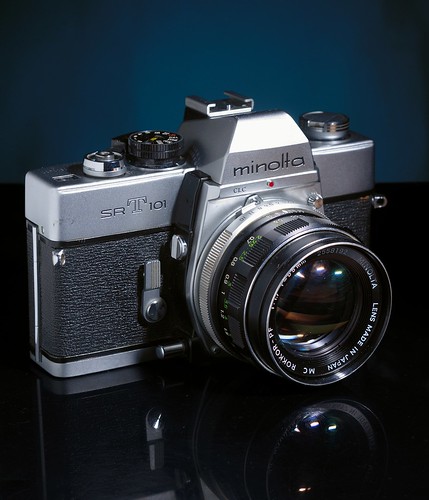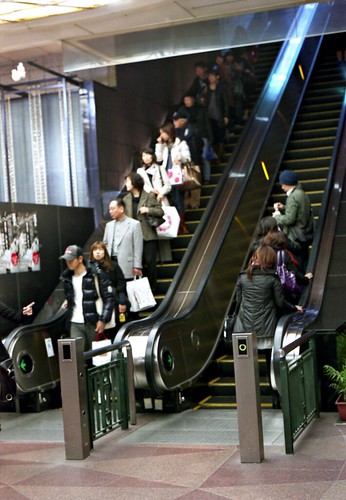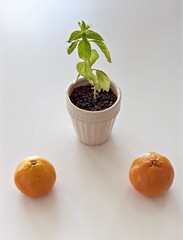The Minolta SRT101 is one of the classic cameras of the 1970's. It was introduced in 1966 and was in production for fifteen years - an eternity by today's standards. It was hugely popular, in part because of its light-metering system, but also because it is an extremely solid, reliable camera with a large array of high-quality lenses available. This is not a "vintage camera"; it is quite capable of excellent results used today, and apart from autofocus there is nothing this camera lacks compared to its modern counterparts. Except for it being a film camera, of course; I'll come to that.
This is notable for being one of the first mainstream cameras with "open aperture metering". It meant that unlike earlier SLR cameras, the lens aperture setting is coupled to the body, so the camera knows which aperture you would be using. The light meter measures the light with the lens wide open, then compensates for the aperture you'll actually use. Very convenient, and perhaps obvious today, but it was a real innovation at the time.
This camera has several other real benefits such as a dedicated mirror lock-up knob. When you take a picture, the mirror inside slams up so the light can reach the shutter instead of the viewfinder, but that jolts the camera and creates blur at lower shutter speeds. To avoid that, especially on a tripod, you want to fold up the mirror beforehand. Many modern DSLR cameras unfortunately hide this useful function in some obscure menu (Pentax, to their credit, have a really smart function for this). This camera has a very convenient dedicated lever for it. And when something is convenient you tend to use it, which results in better images.
But the most notable feature of this camera is the body itself. It's squared-off, all metal, and built to last. To make it short, it feels like a steel ingot in your hands. This is good and bad. Good thing is, it can probably take quite a lot of abuse with only superficial wear and tear. On the downside, it really is quite heavy; it certainly feels heavier than my K10D despite being a lot smaller. It's dangerous in a way; it feels so solid and reliable you tend to forget to be careful. And solid or not, if you bang it hard enough the small mechanical assemblies inside are not going to like it very much. In reality, of course, modern camera design with a rigid metal cage surrounded by a plastic shell is lighter, cheaper and just as durable, if not more so.
But the most notable feature of this camera is the body itself. It's squared-off, all metal, and built to last. To make it short, it feels like a steel ingot in your hands. This is good and bad. Good thing is, it can probably take quite a lot of abuse with only superficial wear and tear. On the downside, it really is quite heavy; it certainly feels heavier than my K10D despite being a lot smaller. It's dangerous in a way; it feels so solid and reliable you tend to forget to be careful. And solid or not, if you bang it hard enough the small mechanical assemblies inside are not going to like it very much. In reality, of course, modern camera design with a rigid metal cage surrounded by a plastic shell is lighter, cheaper and just as durable, if not more so.
But while the time of all-metal bodies have gone, the shape is a different matter: A square slab with well-defined edges feels much better in your hands than the rather bulbous, swollen camera bodies of today. A modern DSLR feels like a large balloon-animal toy version of the Minolta. They look like they have the mumps. I really, really wished camera makers could return to this kind of sleek, well defined body shape.
As far as taking pictures with the Minolta, things are remarkably simple. Look through the viewfinder, adjust aperture and shutter speed until a little paddle thingy matches the light meter needle, focus and shoot. Film has a remarkable latitude so this simple light meter is plenty accurate enough, and as the camera has an old-style coarse ground glass it's very easy to see when you're in focus (unlike today's brighter but smaller viewfinders).
Our basil plant just before we cut it down to make pesto; and the escalators in Crysta Nagahori leading up to the street level. White balance used to be an issue with film, but when you process the images digitally you can tweak it as much as you want.
And About That Film Issue?
The last issue is that of film. I've already mentioned that I've started to use film in addition to digital. But that is medium-format film, and black and white rather than color. the thing is, the larger the film area the easier it is to get good results, and the easier it is to scan. We may think of 35mm - and APS format digital SLRs - as a consumer format, if we even realize that other formats exist. But because the film or sensor area is relatively small it needs higher quality lenses and higher precision than medium format to achieve good results.
Medium and large-format lenses are usually less sharp and resolve less detail than 35mm lenses, and - counterintuitively for a "professional" format - they are cheaper as a result. Sure, there are medium format lenses that approach the resolution of a good 35mm lens but they're relatively rare and expensive. With all that sensor area medium format lenses don't need to be very sharp; instead some sharpness is sacrificed in exchange for lower noise and higher dynamic range.
The same scene shot with 35mm film (left) and digital SLR (right). Somewhat different colors, and a somewhat more muted rendering with the film version than the digital one. I think I prefer the film version in this case.
As far as resolution there's no meaningful difference I can see when comparing the negative with the digital file. In reality, neither film nor digital camera sensors are constrained by resolution any more; it's other factors like lens aberrations and resolution, diffraction and so on that are the limits today.
This same principle holds at the other end too. Medium format negatives are really large and forgiving so even a mediocre scanner will still get a high resolution, decent quality scan out of it. But with the small frame size of a 35mm negative you need a better scanner for decent results. We have two scanners at home - an old but good quality flatbed that Ritsuko uses for work and I scan medium format with, and our HP all-in-one printer, copier and scanner which also has the ability to scan 35mm film.
The good quality flatbed does a decent job, with low noise and OK color rendering, though white balance needs to be adjusted afterwards. Flatbed scanners normally achieve only half their theoretical optical resolution or even less, however, so at a practical limit of 1200 dpi this one gives rather small images for 35mm. The all-in-one is a fine document scanner and copier but for film it gives results so bad that I won't even show them here; they're completely useless, with lots of shadow noise with some strange random shot noise, blocked highlights, striping and wonky color rendering (not just a white balance problem, but wrong altogether). Lesson: for scanners the low end really can be worse than nothing.
In the End
I'll keep using this camera, I think. It's a stellar camera and the 50/1.7 normal on it does it justice. For all its bulk it is still smaller than my MF cameras, and it should be fun to keep it in the bag as an always-around camera. Not sure if I'll keep using color film or if I go with BW here too, and start developing 35mm myself as well. Time will tell. The whole set of images is available here.







It is regrettable we have lost Minolta, which made CLE and XD.
ReplyDeletei just bought an SRT 101 of ebay! i can't wait to receive it!!! you're review was very helpful. thanks!
ReplyDeleteCongrats! It's an amazingly solid, well thought out camera. Have fun with it!
ReplyDeleteBest camera ever!
ReplyDeleteActually, while I bought a SRT-101a new in 1969, and now have three copies the SRT-102a is marginally a better camera. it is virtually identical with two small but meaningful changes. The 1st is a horizontal focusing split for faster, more precise focusing (IMO) and the 2nd is aperture readout in the viewfinder. Otherwise the early 101a and the 102a are indentical right down ot the mirror lockup (MLU). I love both though I actually current get greater satisfaction out of my 101a since I used it so long as a youngster.
ReplyDeleteAnother fine camera was the Olympus OM1. A good friend owns a working example and I am planning to make her a ridiculously low offer for it.
ReplyDeleteNever tried the OM1. So far I've been good at keeping my used gear shopping to a minimum so that one's not on my list.
ReplyDeletehi. I was really inspired by your blog, i think its really cool. I was thinking of buying a minolta x700 film camera from an antique shop, it was still working. i wont be using it for work or everyday activities, i just thought that it looked really cool because we love older stuff rather than the modern ones. i would really appreciate it if you could share a few ideas about that model. i just want to make sure that its would be worth every penny. :) thanks so much
ReplyDeleteThe x700 is a good camera. It was their low-to midlevel camera for many years. I've never used one myself, but it seems like a very good buy if the price is right.
ReplyDeleteMinolta was a really good camera maker, and they only disappeared because they were too slow to adopt the auto-everything design concept. If you're not in a hurry, a manual camera is of course more fun, so they're a really good buy nowadays.
Here's some good information on it: Minolta x700